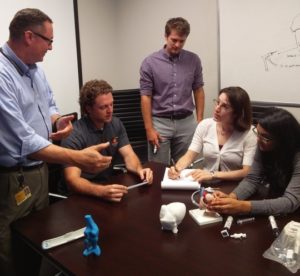At the end of verification and validation, a medical product is ready for regulatory submission or marketing, depending on the product’s regulatory classification. The manufacturing transfer phase typically follows, ensuring that high quality products can be made at sufficient product volumes.
Note: Industry uses “manufacturing transfer” and “transfer to production” interchangeably as you may see here.
Transfer to production activities ensure high quality products can be made at sufficient scale, quality and acceptable cost. Activities include the transfer of knowledge and responsibilities for new medical products from the research and development (R&D) team to the manufacturing and operations team. R&D involvement tapers off as manufacturing transfer progresses. Operations team members include manufacturing engineering, quality assurance and technical operators. These teams may include external contract manufacturers or internal manufacturing teams where applicable.
Not all production is created equally. The R&D process includes determining manufacturing procedures and running small (pilot) builds for design verification and initial clinical use. Once verified and approved, the operations team can then scale production to satisfy demand.
Transfer to Production: Process, Elements and Goals
What is a production process? In the medical industry, defined processes are used to make products. Each process has inputs (materials, components, design specifications, quality requirements), manufacturing activities (step by step instructions, inspection methods), and outputs (components or devices).
Manufacturing transfer aims to finalize all production processes, ensure complete documentation and confirm product quality. Process risk assessments, manufacturing process validations and supplier approvals are critical elements of the transfer to production phase. Other elements include:
- Finalizing the device history file (DHF)
- Finalizing the device master record (DMR)
- Creating a master validation plan (MVP) to track the readiness of all processes
- Confirming manufacturing line readiness to ensure appropriate equipment, space and staff are prepared
- Calibrating and qualifying equipment to ensure proper installation and operation
- Completing supply and quality contracts with vendors
- Finalizing inspection procedures including defining inspection sample size for each lot of parts
- Training production staff on procedures
Process Risk Assessment – what is it, and what activities does it drive?
A process risk assessment ensures that whatever the process, the device is safe, of high quality, effective and meets the intended use. GCMI executes process risk assessment using a PFMEA (process failure modes and effects analysis).
Process validation – what is it, and why is it useful?
Regulatory agencies require that product quality is either inspected every time a product is built, or that the processes have been validated to confirm they will produce quality products. Process validation characterizes the output of the process to ensure the resulting product meets specifications. With that data in hand, the manufacturing team has objective evidence to justify performing fewer individual inspections on the results of that process.
How to approve and control your suppliers
Suppliers are assessed, approved, controlled, and monitored through the supplier evaluation process, which falls under purchasing controls 21 CFR 820 Subpart E (820.50). The supplier evaluation process assesses the supplier’s technical ability and the level of quality they can meet for components or services they are supplying for the product.
Comprehensive process engagement helps ensure high quality through scale up
The manufacturing team must remain engaged with all aspects of the process – from materials to final product – to ensure high quality even after scale up.
About GCMI’s Design and Development Process
 Project success is dependent on careful consideration of several intersecting aspects: technological, clinical, commercial and legal. We follow a structured, phase-gated process that allows for a disciplined medical device design and product development approach. Our medical device design services and development process encourages an early focus on clear problem definition and de-risking a wide variety of potential solutions. By later phases, the funnel of medical device design options narrows significantly, converging on a final product that has been thoroughly shown to meet the customer needs and is ready for distribution.
Project success is dependent on careful consideration of several intersecting aspects: technological, clinical, commercial and legal. We follow a structured, phase-gated process that allows for a disciplined medical device design and product development approach. Our medical device design services and development process encourages an early focus on clear problem definition and de-risking a wide variety of potential solutions. By later phases, the funnel of medical device design options narrows significantly, converging on a final product that has been thoroughly shown to meet the customer needs and is ready for distribution.
When you’re ready to get the conversation started, email info@gcmiatl.com.
